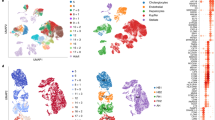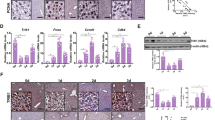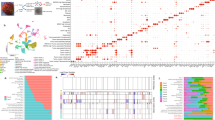ABSTRACT
A non-radioisotopic, quantitative TRAP-based telomerase activity assay was established mainly by using SYBR Green-I staining instead of radioisotope. Comparing with conventional radioisotope based method, it was better in reproducibility and accuracy. Using this method, we found telomerase activities were absent in normal human liver cells, while detected in all of four human hepatoma cell lines (BEL-7404, SMMC-7721, QGY-7903 and HCCM) without significant differences.
Similar content being viewed by others
Log in or create a free account to read this content
Gain free access to this article, as well as selected content from this journal and more on nature.com
or
References
Zhang RG, Yuan JH, Xie H . Telomerase and tumor. Chinese Journal of Cell Biology 2000; 22:25–7.
Zhang RG, Yuan JH, Wang XW, Xu B, Xie H . Telomerase: a novel target of antitumor agents. Chinese Journal of Oncology Research. In press.
Kim WK, Piatyszek MA, Prowse KR, et al. Specific association of human telomerase activity with immortal cells and cancer. Science 1994; 266:2011–15.
Krupp G, Kuhne K, Tamm S, et al. Molecular basis of artifacts in the detection of telomerase activity and a modified primer for a more robust 'TRAP' assay. Nucleic Acids Research 1997; 25:919–21.
Kim NW, Wu F . Advances in quantification and characterization of telomerase activity by the telomeric repeat amplification protocol (TRAP). Nucleic Acids Research 1997; 25:2595–7.
Kim NW . Clinical implications of telomerase in cancer. European Journal of Cancer 1997; 33:781–6.
Tay N, Chan SH, Ren EC . Detection of integrated hepatitis B virus DNA in hepatocellular carcinoma cell lines by nonradioactive in situ hybridization. Journal of Medical Virology 1990; 30:266–71.
Albanell J, Lonardo F, Rusch V, et al. High telomerase activity in primery lung cancers: association with increased cell proliferation rates and advanced pathologic stage. Journal of the National Cancer Institute 1997; 89:1609–15.
Zhang RG, Yuan JH, Wang XW, Xie H . Inhibition of telomerase activity of BEL-7404 human hepatoma cells by its RNA component antisense oligonucleotides and their effects on cell cycle in vitro. Acta Pharmacologica Sinica. In press.
Author information
Authors and Affiliations
Corresponding author
Rights and permissions
About this article
Cite this article
ZHANG, R., WANG, X., YUAN, J. et al. Using a non-radioisotopic, quantitative TRAP-based method detecting telomerase activities in human hepatoma cells. Cell Res 10, 71–77 (2000). https://doi.org/10.1038/sj.cr.7290037
Received:
Revised:
Accepted:
Issue date:
DOI: https://doi.org/10.1038/sj.cr.7290037
Keywords
This article is cited by
-
Combined treatment with emodin and a telomerase inhibitor induces significant telomere damage/dysfunction and cell death
Cell Death & Disease (2019)
-
The Maintenance of Telomere Length in CD28+ T Cells During T Lymphocyte Stimulation
Scientific Reports (2017)
-
Telomere and telomerase in oncology
Cell Research (2002)
-
Effects of cisplatin on telomerase activity and telomere length in BEL-7404 human hepatoma cells
Cell Research (2002)
-
Telomerase: A novel target of antitumor agents
Chinese Journal of Cancer Research (2000)



